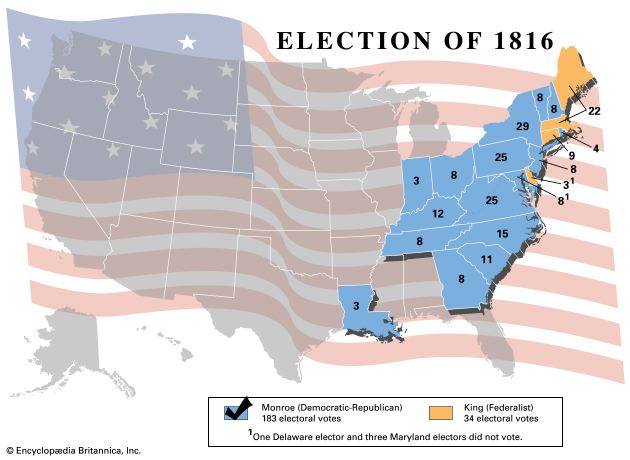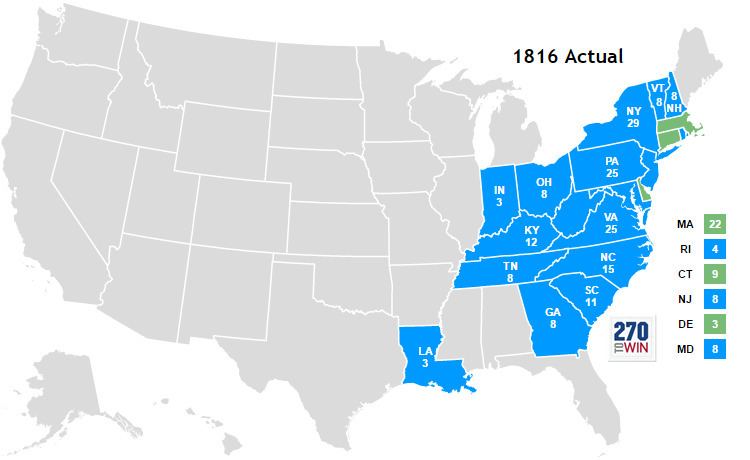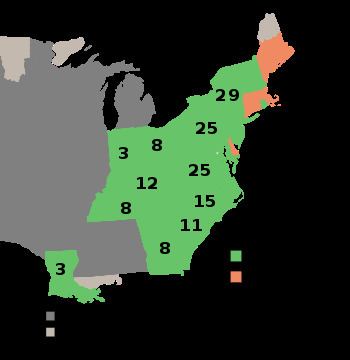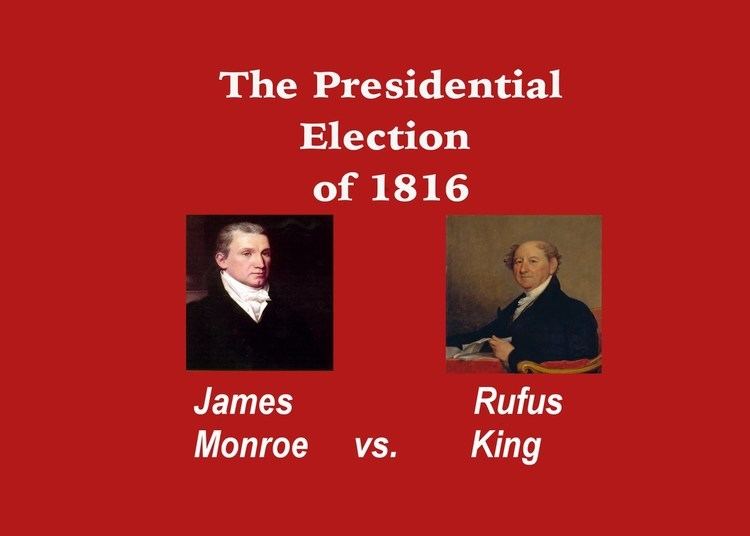November 1 – December 4, 1816 1820 → Electoral vote 183 Home state Virginia Party Democratic-Republican | Start date 1816 Popular vote 76,592 Running mate Daniel D. Tompkins Percentage 68.2% | |
 | ||
The United States presidential election of 1816 was the eighth quadrennial presidential election. It was held from Friday, November 1 to Wednesday, December 4, 1816. It came at the end of the two-term presidency of Democratic-Republican James Madison. With the Federalist Party on the verge of collapse, Madison's Secretary of State, James Monroe, had an overwhelming advantage against very weak opposition. Monroe won the electoral college by the wide margin of 183 to 34.
Contents

The previous four years of American politics were dominated by the effects of the War of 1812. While the war had not ended in victory, the peace concluded in 1815 was satisfactory to the American people, and the Democratic-Republicans received the credit for its conclusion. The Federalists found themselves discredited by their opposition to the war and the secessionist rhetoric from New England embodied by the Hartford Convention of 1814-15. Furthermore, President Madison had succeeded in realizing certain measures favored by the Federalists, for example a national bank and protective tariffs. This gave the Federalists few issues to campaign on, and this resulted in an overwhelming victory for the Democratic-Republicans.


Monroe was the favorite candidate of both former President Jefferson and retiring President Madison. However, Monroe faced stiff competition from Secretary of War William H. Crawford of Georgia. Also, there was widespread sentiment, especially in New York, that it was time to end the Virginia dynasty of presidents. But Monroe's long record of service at home and abroad made him a fitting candidate to succeed Madison. Crawford never formally declared himself a candidate, because he believed that he had little chance against Monroe and feared such a contest might deny him a place in the new cabinet. Still, Crawford's supporters posed a significant challenge.

In March 1816, Democratic-Republican congressmen in caucus nominated Monroe for President and New York Governor Daniel D. Tompkins for Vice President. Monroe defeated Crawford for the nomination by a vote of 65 to 54.
Federalist Party nomination
Federalist candidates
The Federalist caucus did not even bother to make a formal nomination, although many Federalists supported New York Senator Rufus King, who had been defeated twice before as the Federalist vice presidential candidate. Former Senator John Eager Howard of Maryland was the principal Federalist candidate for vice president.
Dispute about Indiana
On February 12, 1817, the House and Senate met in joint session to count the electoral votes for President and Vice President. The count proceeded without incident until the roll came to the last state to be counted, Indiana. At that point, Representative John W. Taylor of New York objected to the counting of Indiana's votes. He argued that Congress had acknowledged the statehood of Indiana in a joint resolution on December 11, 1816, whereas the ballots of the Electoral College had been cast on December 4, 1816. He claimed that at the time of the balloting, there had been merely a Territory of Indiana, not a State of Indiana. Other representatives contradicted Taylor, asserting that the joint resolution merely recognized that Indiana had already joined the Union by forming a state constitution and government on June 29, 1816. These representatives pointed out that both the House and Senate had seated members from Indiana who had been elected prior to the joint resolution, which would have been unconstitutional had Indiana not been a state at the time of their election. Representative Samuel D. Ingham then moved that the question be postponed indefinitely. The House agreed almost unanimously, and the Senate was brought back in to count the electoral votes from Indiana.
Results
When the votes were counted, Monroe had won all but three of the nineteen states. King thought that a Monroe victory was inevitable, and did not seriously contest the election.
Each of the three states that were won by King voted for a different person for Vice President. Massachusetts electors voted for former United States Senator (and future Governor) John Eager Howard of Maryland. Delaware chose a different Marylander, sitting United States Senator Robert Goodloe Harper. Connecticut split its vote between James Ross of Pennsylvania and Chief Justice John Marshall.
Maryland did not choose its electors as a slate; rather, it divided itself into electoral districts, with each district choosing one elector. Three of Maryland's eleven districts were won by Federalist electors. However, these electors did not vote for King or for a Federalist vice president, instead casting blank votes as a protest, thus resulting in Monroe winning the votes of all the Maryland state electors.
Source (Popular Vote): A New Nation Votes: American Election Returns 1787-1825
(a) Only 10 of the 19 states chose electors by popular vote.
(b) Those states that did choose electors by popular vote had widely varying restrictions on suffrage via property requirements.
(c) One Elector from Delaware and three Electors from Maryland did not vote.
